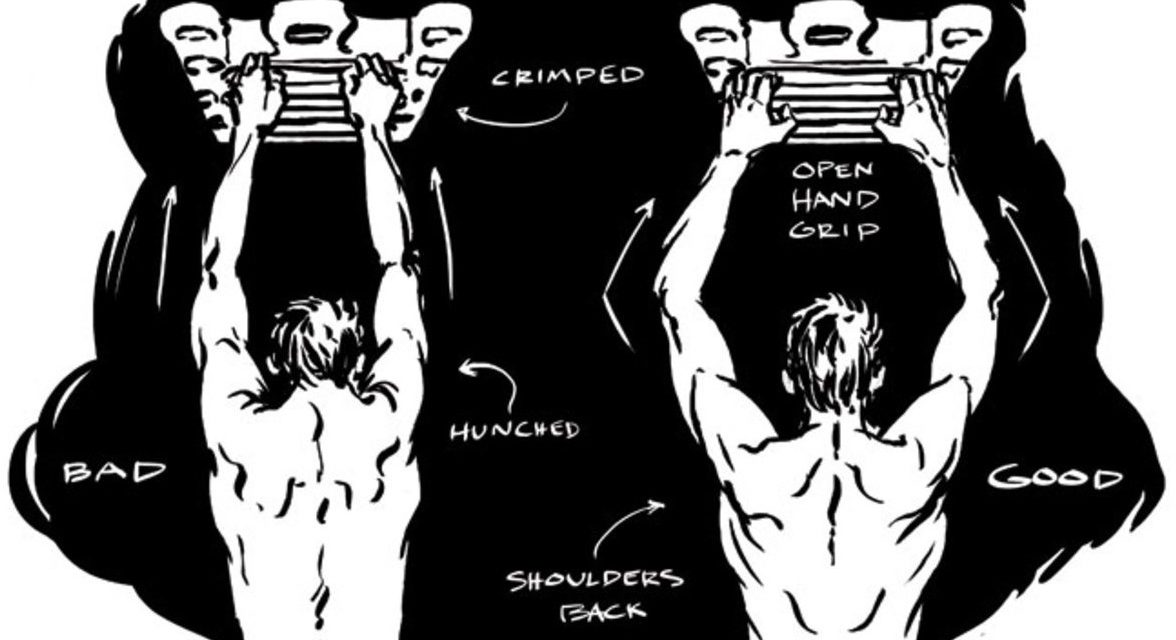Perhaps the greatest benefit of a sports-science approach to rock climbing is the ability to assess a climber’s level of ability in specific motor patterns and compare their results to their peers’ results. The science is far from perfect for a multitude of reasons, but the intent is to quantify and measure your physical abilities and then compare yourself to the majority of climbers around your overall ability level. This process is commonly referred to as developing or setting your benchmark.
The benchmarks I use to assess a climber’s abilities are simply called “Levels.” My method for assessing a level is simple: if you boulder climb at the Vx level, you probably have similar levels of strength and mobility as other climbers who climb Vx boulders, but lower levels compared to Vx+1 climbers. In reality, your level of performance is determined by a great deal of factors, physical ones being only a small piece of the puzzle, which is why I prefer to avoid using climbing grades as benchmarks when talking about strength. The levels break down like this:
Level 0 = Reasonable, should be improved
Level 1 = Good, could be improved
Level 2 = Great, probably doesn’t need work
Level 3 = World class, not your issue
Below, I’ve listed the assessment exercises and their corresponding benchmark figures. But first, I have to issue a disclaimer. This assessment is of my own design. I use it for myself and my clients and it has proven effective in my experience thus far. I have no doubt that it bears striking similarities to other coaches’ assessment protocols (as it should, if we climbing coaches are worth anything), but that doesn’t imply any collaboration or exchange of data between myself and anyone else. There is no universal data pool or standardized assessment. As such, every assessment is prone to error and over-generalization. Please remember that these exercises and benchmarks don’t necessarily correlate directly to climbing performance, they simply highlight weak links in fundamental strength and mobility.
Furthermore, and most importantly, DO NOT attempt to assess yourself in any exercise unless you are familiar with proper form. Testing max strength is extremely strenuous, and therefore extremely dangerous. I highly recommend you enlist the help of a coach or other knowledgeable individual if you are unsure of proper technique. At the very least, you MUST familiarize yourself with the exercises at a very low intensity prior to maximum testing.
TIP: If you know the proper form for these exercises and you’re interested in assessing yourself, but you’re uncomfortable testing your 1 rep max, you can do some math instead. Instead of testing for your 1 rep max, test for your 3 rep max and multiply that number by 1.11. Why? Your 3 rep max correlates to roughly 90% of your 1 rep max.
Please note that these charts are for reference only. They are not intended as guides for how to assess the exercises contained therein. Download the .pdf here.
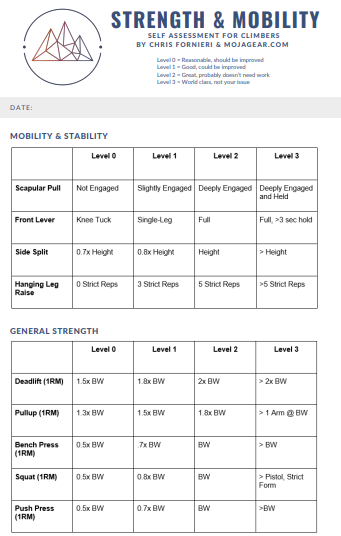

While I won’t attempt to thoroughly describe proper form for each of these exercises, I do need to specify some aspects of form to ensure accurate testing. Most of these exercises have multiple variations, so I want to be clear about what you should be doing.
Scapular Pull
This is probably the single most important thing to test if you are new to training. The scapular pull tests your ability to properly engage your shoulders while deadhanging, which is an essential ability for nearly all climbing-specific training and, frankly, for good climbing form. That said, this should also be one of the easiest tests to score well on. Simply hang from a bar or the jugs on a hangboard with straight arms, and engage your shoulders as deeply as possible. Think about it like preparing to do a pull-up without bending your arms. You’ll feel some external rotation in your shoulders as they engage downward and backward, almost like you’re trying to squeeze your shoulder blades together. Your chest should rise towards the bar slightly. The deeper the engagement, the more your chest will rise and the more you’ll lean away from the bar.
Front Lever
For assessment purposes, we’re only interested in a few of the many lever variations that exist. The knee tuck is just how it sounds: tuck your knees to your chest, and then lever. Single-leg is levering with one leg tucked while the other leg is extended. Full is both legs extended.
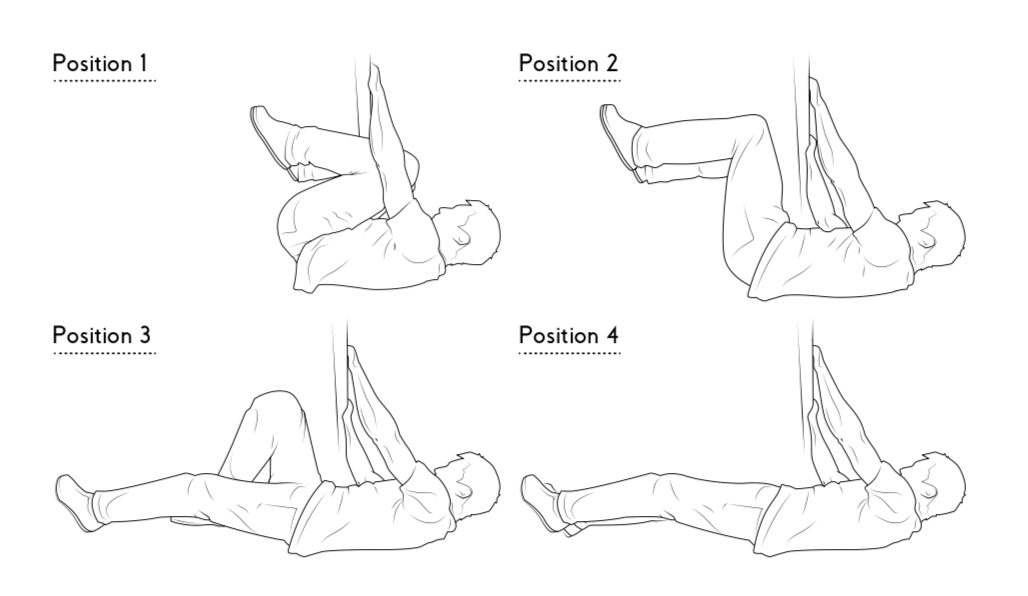
Side Split
Measure your height and mark it out on the floor using whatever is handy or within reach, such as random bits and bobs, socks, or just your memory. Stand sideways with the outside of one foot against one of your markers. Take small lateral steps with the inside foot farther and farther away from your foot by the marker. When you can no longer step farther away without assisting yourself (hands on the floor, counter, etc.), that’s your score.
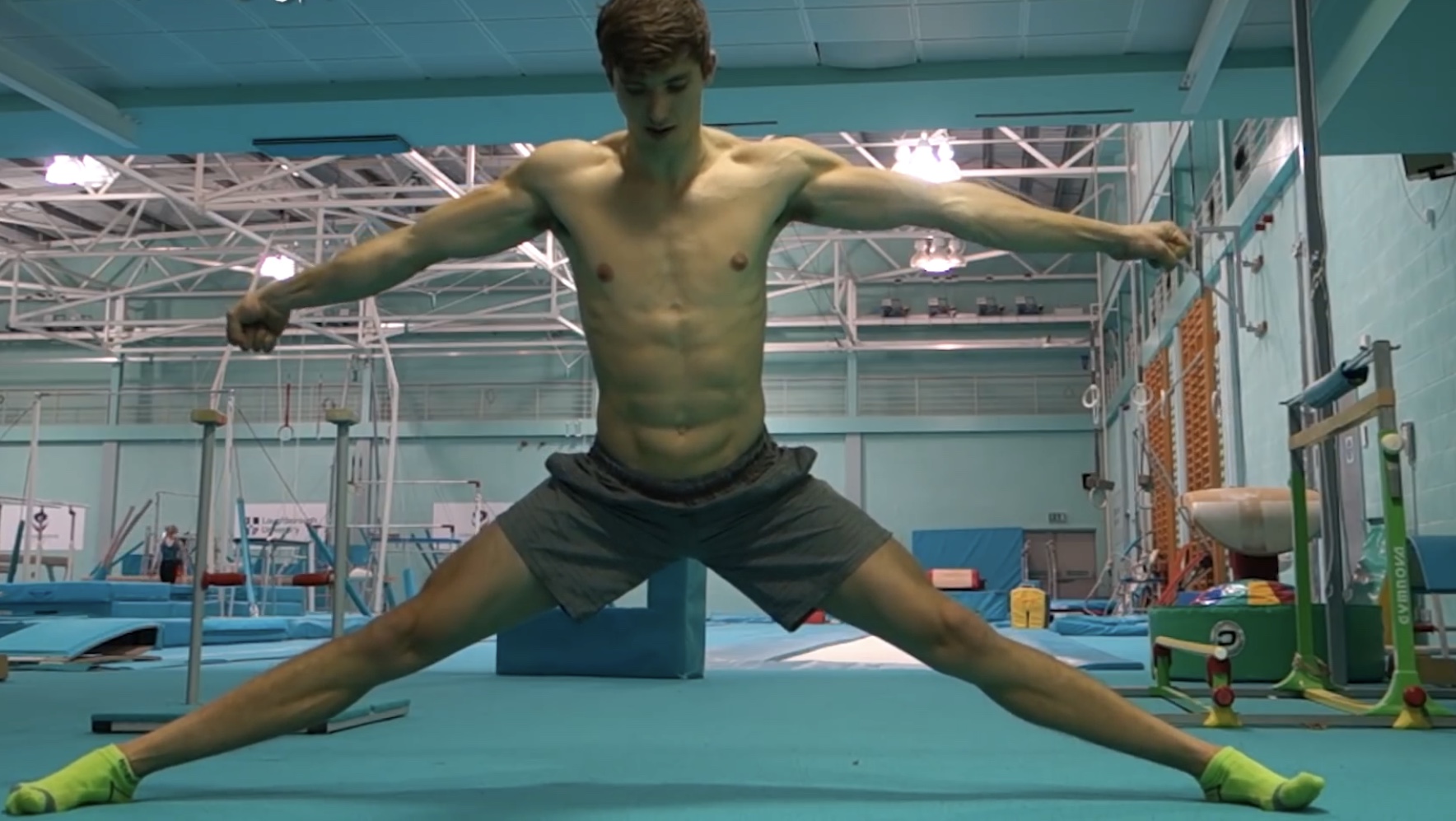
Hanging Leg Raise
a.k.a. Toe-to-bar. Arms straight, shoulders engaged, full range of motion. That means your feet should touch the bar between your hands. Lower slowly and don’t break tension before repeating for another rep. These are harder than you think.
Pull-up
Not chin-ups, but rather tactical pull-ups. That means an overhand grip, hands just slightly wider than shoulder width, thumbs on the same side of the bar as your fingers (hands draped over the bar, not squeezing it). Move slowly throughout the motion, don’t break tension. Get your chin over the bar or it doesn’t count.
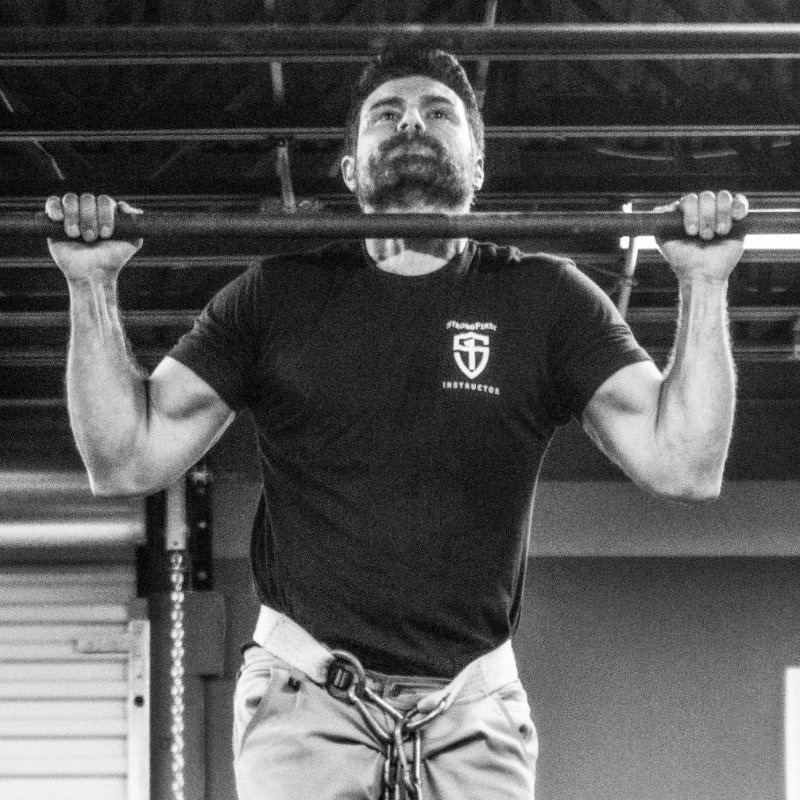
Squat
Ass-to-grass back squats, not those wimpy parallels. We want the full range of motion. Don’t allow your knees to move in front of your toes. Feet should be planted just slightly wider than shoulder width. Okay, you won’t literally touch the floor with your butt, but you should get darn close. The key is full range of motion.
Max Hangs
Hang from a hangboard the way you’d hang from a pull-up bar during a set of pull-ups: shoulders engaged, arms straight (slightly bent elbows are fine), core tight. Don’t hang from your bones unless you like getting injured and don’t like getting stronger.
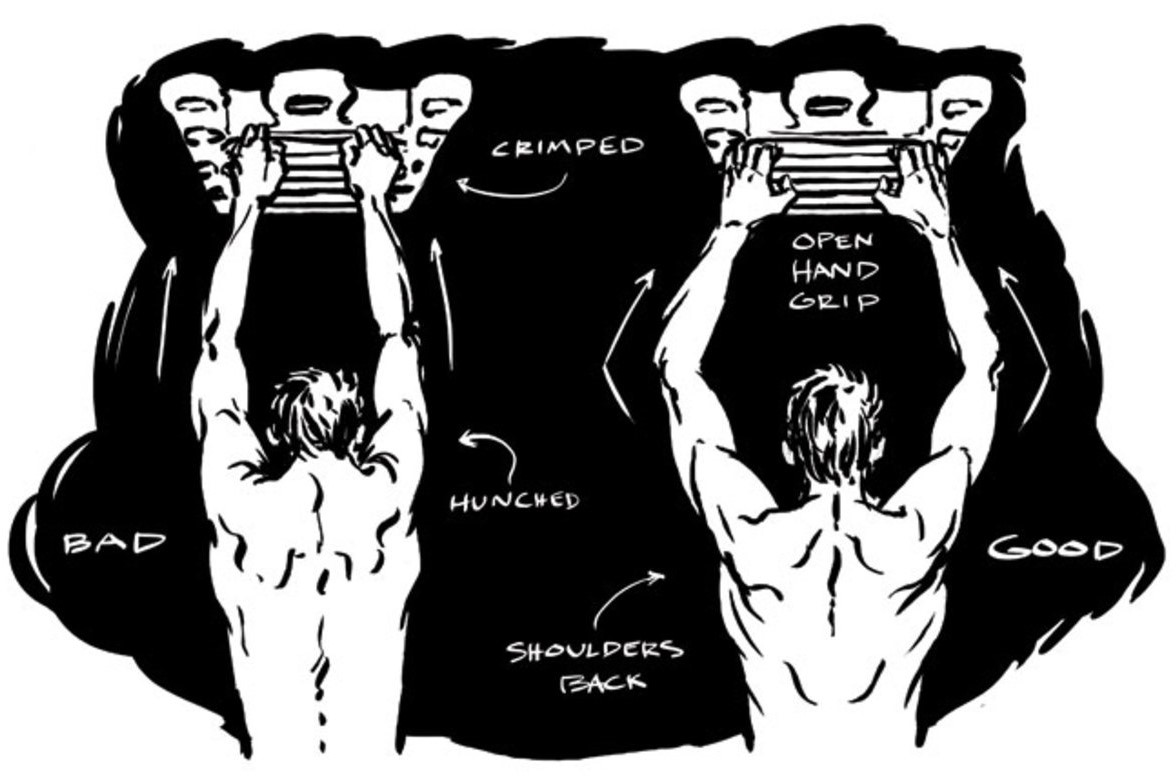
Final Thoughts
You may have noticed that Level 0 is actually quite hard. It’s a perfectly respectable level of strength that I feel is a reasonable expectation for most people that have been climbing for at least a few months and have routinely pushed their limits on the wall. As such, I have no doubt that many climbers would fail to achieve a score that puts them in Level 0. These are likely the climbers that play it safe, don’t try anything hard, or simply haven’t been climbing for very long. These climbers should ask themselves the following question: “Do I need extra training or am I still getting better and stronger by climbing?” You’ve heard it before, but I’ll say it again:
If you are still getting stronger and better by just climbing, then just climb!
Many coaches will use different benchmark figures for male and female athletes, but I don’t. Why? Maybe I’m a bit of a reductionist on this topic, but I believe that the numbers I’ve provided are worthy markers for all climbers regardless of physiological differences. Sure, male athletes are generally more predisposed to upper body strength than female athletes, but that doesn’t mean Alex Puccio can’t crank out more one-arm pull-ups than most dudes. We’ve all got different physiology and different genetics that predispose us to different things, so what’s the sense in drawing lines between the sexes? Just because your biology or genetics or whatever else may predispose you towards certain aspects of fitness and away from others doesn’t mean that hard work and dedication can’t have the final say in your abilities. Take me for example: I’m 5’5” with an ape index of -0.5” and a predisposition to bulky muscles. Short and stocky, the opposite of an ideal climber’s body. Doesn’t mean I can’t climb with the best, it just means I have to work harder to keep up.
There’s no such thing as too much finger strength.
Finger strength can and should be improved constantly. There’s a reason why I haven’t had a finger injury since I started climbing ~20 years ago: because my fingers are stronger than steel. In fact, they’re the strongest part of my body; I’m not even capable of generating enough force in any motor pattern to overpower my fingers. And I still train them all the time. Maybe you should too.
As I’ve said countless times, climbing performance is determined by many factors, number one being technical proficiency. Getting stronger will not magically improve your climbing. Don’t make the mistake of studying for the test; that is, training to pull world class strength numbers because you think it’ll make you a world class climber. It’s easy to lose perspective sometimes, so follow these two simple rules: for every hour you spend in the weight room, spend 2-3 hours actually climbing. And when you have to choose between climbing or training, climb! It’s why you’re doing all this in the first place!

